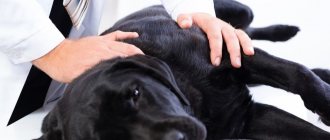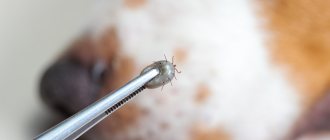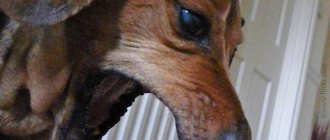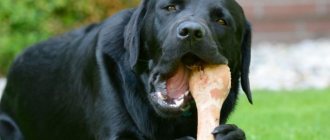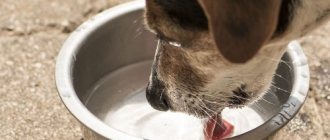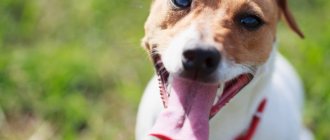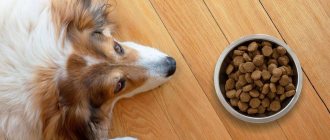We identify the spring-summer period with the activity of all living things.
Our pets are no exception; while walking in nature, they run the risk of encountering stinging insects.
Dog on a walk
A wasp sting can have a variety of consequences. In some cases, everything is limited to slight swelling and subsequent moderate itching, the problem will begin to disappear.
Sometimes serious complications such as allergies and even anaphylactic shock are possible. In the latter case, a real threat to the life of the animal is created.
The severity of the signs depends on the age characteristics of the pet, the point of the bite, the specifics of the body, and the reaction of the immune system. Despite the different situations, animal owners need to know what to do if their dog is bitten by a wasp.
You can also read our article: What to do if a cat is bitten by a wasp
Bite signs and symptoms
There are situations in which the dog owner misses the moment of the bite, in which case it is necessary to determine whether the attack was caused by a bee or a wasp. If a bee suddenly bites a dog for unknown reasons, a sting remains at the site of the wound, periodically pulsating and releasing more and more poison into the blood. During a wasp attack, the bite can be applied several times, but this insect does not leave a sting.
In addition to physical symptoms, the dog’s mood will most likely begin to change - his health will worsen, and his temperature may rise. If a puppy is attacked, it will be easier to identify the bite, since the small pet will whine loudly and ask for help from the owner.
There is a short list of symptoms that will help determine whether a bite has been inflicted:
- the appearance of edema;
- formation of dried blood in the bite area;
- strong temperature fluctuations;
- increased salivation;
- sudden loss of appetite;
- severe fatigue;
- vomiting reflex;
- difficulty breathing;
- the formation of urticaria on the body;
- the appearance of a purple tint on the tongue;
- foaming at the mouth;
- sudden convulsions;
- fainting.
- gnawing, licking the damaged area with his tongue;
- refuses to step on the sore paw, especially if the insect has stung the pad;
- whines when walking.
- Acute pain localized to a small area of the skin.
- Severe swelling, swelling, which can rapidly increase. Swelling is especially pronounced if the wasp has bitten the mucous membranes, for example, the oral cavity, eyelids.
- Redness.
- A small amount of blood may appear in the center of the wound.
- The next day after the dog receives a bite, severe itching and burning may occur.
Bite in the face
If a wasp bites a dog in the face as a result of an animal’s aggression, you should urgently contact a veterinarian. It's all about the location of a large amount of soft tissue on the dog's face, as well as the presence of mucous membrane in the mouth area. Often the dog tries to catch an insect with its mouth, not suspecting that it will receive serious injury from a small enemy.
Dogs of small breeds, such as pugs, dachshunds, Pekingese, quinines, etc., suffer most from bites in the face. This problem lies in the manifestation of a high heart rate in small dogs. Accordingly, the poison spreads throughout the body much faster and causes an increase in temperature that accompanies intoxication.
When an animal's muzzle suffers, it is very easy to determine - the dog barks loudly and tries to smooth out the bite site with its paw. In frequent cases, loss of appetite occurs, swelling occurs, and the airways become inflamed.
Curious nose
It is he who most often suffers from flying insects. Dogs love to catch flies, and can also knock down a striped wasp on the fly. However, this insect knows how to stand up for itself. If a dog is bitten in the face by a wasp, then there is serious cause for concern. The consequences can be catastrophic. It is very dangerous if the bite is on the neck or lip. Swelling can develop almost instantly. It will prevent air from entering the lungs, which will lead to death.
Ears
One of the weak points is the ears. A swelling forms at the site of the bite and hardening occurs. A clear symptom for a dog that has been bitten by a bee or wasp is a loud squeal from the animal. The pet tries to relieve the pain and itching that has arisen, scratching the ear with its paw.
If such symptoms are detected, it is necessary to carefully examine the animal. Do you have significant swelling or swelling that is making it difficult to breathe? You should immediately contact your veterinarian for emergency treatment.
Paws
After a painful bite, a four-legged friend behaves as follows:
A pet that has been bitten by bees may develop general weakness and stress caused by a sudden fright.
Bite to the body
If bitten in any area of the body, a wide variety of consequences can occur. Basically, such an attack is accompanied by swelling, hives and general weakness, however, there are situations when the animal loses consciousness or suffers anaphylactic shock. It all depends on the bite area, since the dog’s body has soft tissues that quickly absorb the poison and distribute it throughout the body.
Bite on the tongue area
The most dangerous place for a bite is the tongue area. The fact is that in the sublingual area there is a large number of nerve endings and blood vessels. After being bitten on the tongue, the pet experiences a convulsive reaction and the front muscles begin to contract involuntarily.
In this case, the animal must be placed on its right side and try to calm it down. If the condition does not return to normal within 5 minutes, you should immediately call a veterinarian.
Normal reaction to a bite
After a dog is bitten by a wasp or other stinging insect, a toxic substance enters the animal’s bloodstream, which provokes the appearance of a number of unpleasant, but not dangerous, symptoms for the dog.
The main ones are called:
Stinging insects dangerous to dogs
It’s not entirely correct to say “bitten by a bee,” because bees sting. The same applies to bumblebees, hornets, and wasps, although wasps can bite, using the jaw apparatus for defense. It is important to determine which insect stung the dog; first aid for the pet, aimed at neutralizing the poison, depends on this.
To determine which insect stung the dog, you need to examine the site of the bite. Bees use their sting only once. The bee sting has a bag of poison and barbs, so it remains in the wound, and the bee soon dies.
Worker bumblebees and the queen have a sting, but it is not serrated and insects can use it many times.
Wasps are dangerous because they can sting repeatedly without harm to themselves, and they can use their jaws to protect themselves. Wasp stings are more painful compared to bees.
Large hornets have a smooth sting, so the hornets can use it repeatedly. Compared to other common stinging insects, hornets are more dangerous because they can gnaw through fruits and vegetables while remaining inside. There is a risk of swallowing them along with a bitten piece of fruit.
The danger of bees and other stinging insects for dogs is that the insects react to the smell of poison and fly to the aid of the individual who has begun the attack on the dog. Considering that one individual can attack several times, a group of insects can cause serious harm to the animal.
Causes of animal bites
Every person should know why and how often wasps bite surrounding animals and people. Having familiarized yourself with the reasons in detail, you will be able to protect yourself and your beloved pet.
It is worth remembering that one of the main rules of wasp groups is self-defense, therefore, a wasp will never bite without any reason. A secondary factor is considered to be the manifestation of aggression towards wasps, so you should not hastily wave your arms and drive the insect away from you, as it may regard such behavior as an act of attack.
With animals everything is much more complicated. The owner will not be able to explain to his pet that it is forbidden to attack a wasp as a result of close contact. In this case, it is better to use special means that will prevent the insect from getting closer to the animal. However, situations are different, and special equipment does not always provide the necessary protection, so in any case you should think soberly and not panic.
Advice! If a bite suddenly occurs, you need to quickly treat the wound, but in case of severe swelling or a strong increase in temperature, you should immediately contact a veterinarian.
Precautionary measures
To avoid a wasp sting, you need to teach the animal not to destroy flower beds or climb into flowering bushes. After all, this is where stinging insects may end up.
You need to keep your pet away from wasp nests
When a dog spends a lot of time at the dacha, it is necessary to get rid of wasp nests, if there are any. Most often they can be found under the roof or, if there are building materials or boards on the territory, then insects can settle under them.
Advice! There are special wasp traps that are best placed on the site. The main thing is that the animal cannot reach them.
A dog that spends a lot of time outdoors may be stung by a wasp. There is no need to panic if the dog’s behavior has not changed and he is still cheerful and cheerful. He may be bothered by itching, which will go away on its own. The main thing is that the animal does not scratch the wound that appears.
If the swelling at the site of the bite grows, the animal whines, its coordination is impaired, digestion is upset, you need to urgently go to the veterinarian.
First aid
What should an owner do if his pet, for example a Chihuahua, is bitten by a bee or wasp? Show cold blood and put aside panic. First aid consists of the following:
What to do next to reduce the negative consequences of a bee or wasp sting on a dog? After providing first aid to an adult or puppy, it is necessary to treat any diseases that have appeared: allergies, inflammation, itchy skin. Each of the secondary ailments has its own treatment method.
Folk remedies
If your dog has been bitten by bees or wasps, you need to try to eliminate the unpleasant painful symptoms and prevent infection. Otherwise, it will begin to fester, become swollen, and ulcers will appear. This situation requires the use of local antibiotics and consultation with a veterinarian.
At home, treat the dog with the following means:
- ammonia, medical;
- alcohol tincture of medicinal herbs - valerian, glod, motherwort, calendula are suitable;
- juice of lemon, cucumber, parsley, onion;
- quality vodka;
- citrus;
- vinegar solution - 200 ml of water, 1 teaspoon of table vinegar;
- baking soda paste - moisten with water, stir, apply to the affected area until dry;
- toothpaste;
- shaving foam;
- ice, cold water, a bottle of cool drink, frozen meat;
- decoction of chamomile, mint, lemon balm;
- aloe juice
Folk remedies for wasp bites
On a note!
In field conditions, the bite is treated with the juice of plantain, celandine, dandelion, and washed with water. Upon returning home, they provide qualified assistance.
Allergy
While walking, your dog was stung by a bee or wasp, developed an allergic reaction, and you don’t know what to do? It is urgent to administer an antihistamine. This may be chloropyramine or tavegil. Diphenhydramine shows good results, but pharmacies sell it with a doctor's prescription. Medicines are administered by injection. The dose is selected depending on the size of the bitten dog (its weight).
What should you do if your dog is bitten by a wasp on the cheek or lip and severe swelling develops ? A glucocorticosteroid drug, dexamethasone, . It is an immunosuppressive, anti-inflammatory drug. Used for anaphylactic shock, edema, acute manifestations of allergies. The dosage of the medicine is selected taking into account the size of the dog according to the formulas specified in the instructions.
What to do if a puppy or an adult is bitten by a bee, and the sore spot is itchy and itchy? will help : fenistil, sinaflan . Or traditional hydrocortisone ointment (1%).
You should not self-medicate if the animal has developed an acute form of allergy: the tongue has turned blue, heavy breathing has appeared. You should immediately take your pet to a specialist.
When do you need a veterinarian?
A veterinarian is needed if the dog’s condition worsens, the allergic reaction does not subside, and the dog’s breathing becomes heavy and intermittent. If it seems that the animal is suffocating, then you need to rush to a medical facility.
Important! At the slightest sign of anaphylaxis, you should immediately go to the veterinarian. After all, the pet's life is at risk.
Even if the animal behaves as usual and there are no changes in appearance, it is worth visiting a doctor if you are sure that it was stung in the neck or face. You cannot hesitate if your dog has swallowed a wasp. There is a possibility that the insect did not have time to sting him. But when the dog begins to whine pitifully and tears well up in his eyes, the visit to the clinic cannot be postponed.
What to do if bitten by a hornet
Hornet stings are especially painful. If an animal is attacked by several individuals, you need to contact a specialist; due to the high toxicity of numerous bites, there is a high probability of the animal’s death. The greatest danger is posed by hornet bites if an animal of a small breed is attacked.
If the animal does not show particular concern after being bitten by a hornet, there are no signs of allergies or anaphylactic shock, it is sufficient to use methods classified as alternative medicine.
If there are no negative consequences of a hornet sting, you need to treat the wound with agents that will help prevent swelling, infection, and neutralize pain and discomfort.
Allergic reaction
Signs of allergies can be external or systemic. Appear within 5-20 minutes. A large swelling, swelling, large-scale edema appears on the skin, the diameter of the red spot is more than 1 cm. Additionally, a rash and severe itching are observed. But the most dangerous signs of allergies are systemic. There is a change in the pet's behavior and condition.
- lacrimation;
- increased salivation;
- vomit;
- diarrhea;
- loss of appetite;
- refusal of food;
- drowsiness, apathy or irritability, aggressiveness;
- disturbing sleep;
- convulsions;
- holding your breath;
- violation of movement coordination.
Consequences of a wasp sting for a dog
The worst consequence of an allergic reaction is anaphylactic shock. It is extremely rare, but the potential for its occurrence is always there.
On a note!
If a dog swallows a wasp, there is nothing wrong with it, provided that the insect did not have time to bite. Being in the esophagus, stomach, the likelihood of a bite is reduced. If a dog has eaten a wasp and begins to whine pitifully, you should immediately administer antihistamines yourself or take the animal to the vet if the pet refuses to swallow the tablet.
Prevention of attacks
When walking with your animal, you need to ensure its safety. To do this, do not allow your pet near dense bushes with flowering plants and berries. It is in such places that wasps are most often found. Particular attention should be paid to active breeds, as such dogs show more interest in their surroundings.
Advice! It is best to check the walking area for insects. By following these rules, the owner of the animal will be able to protect his pet from a sudden attack.
By following safety rules and having a veterinary first aid kit with you, you can protect your pet from unforeseen situations. You should be vigilant and closely monitor the animal that is in the territory of flowering plants.
Pharmacy medicines
If the animal has a tendency to allergic reactions, has been bitten by several insects, and also if the dog weighs less than three to five kilograms, it is recommended to use pharmaceutical products. This should also be done in case of multiple insect bites.
The main drugs used to eliminate the consequences of a bite in dogs include:
- Diphenhydramine, suprastin, tavegil. Antihistamines that prevent the development of allergic reactions or eliminate the consequences and manifestations of such. It is recommended to use antihistamines presented in the form of a solution, 1 ml per kg of animal body weight. This type of product helps achieve positive results in a short period of time.
- Dexamethasone. An antihistamine used for anaphylactic shock, which has a powerful effect. The recommended dosage of dexamethasone is up to 10 ml.
- Furosemide, Lasix. Drugs that have a diuretic effect. Used for severe swelling that occurs after a dog wasp bite. Also, drugs in this group are used to remove toxic substances from the animal’s body.
It is equally important to use pharmaceutical preparations intended for external treatment of the bite area.
They have effectiveness:
- Advantan. The given drug helps relieve pain, itching, burning. Approved for treating animals after a bite, regardless of the body weight, breed and age of the dog. Can be used for additional treatment of a pet with severe symptoms of a bite. To obtain the desired effect, apply the product to the skin no more than once a day.
- Star balm. This popular remedy, which is based on natural components of plant origin, can be used to treat bites from small breed dogs or puppies. You can use the medicine only if there is no risk of developing an allergy. To achieve the desired result, it is recommended to apply the balm every two to three hours.
- Fenistil. The drug is presented as drops for oral administration and a balm for application to the skin. You can use two versions of the drug simultaneously. Fenistil has powerful anti-inflammatory, disinfecting, and antibacterial properties. Apply several times until complete healing.
It is not recommended to use medications on your own; incorrect calculation of the dose of the required drug, which varies depending on the age, breed, and weight of the dog, can lead to negative consequences for the animal.

